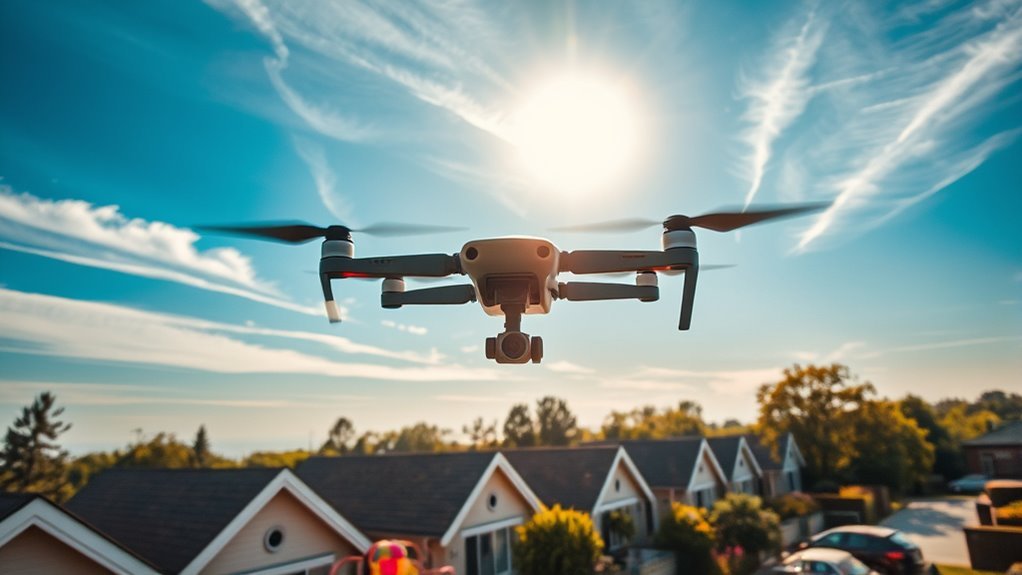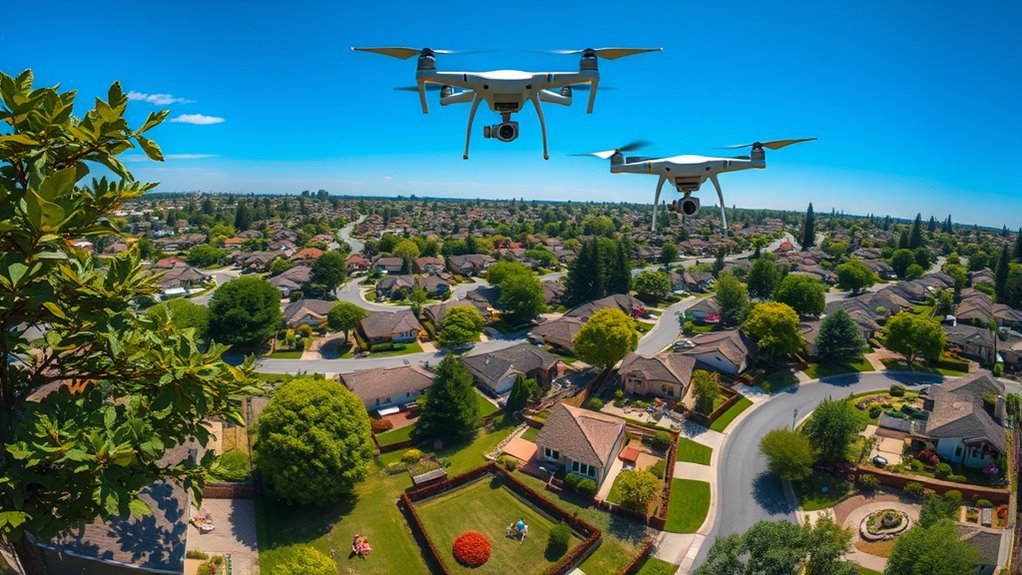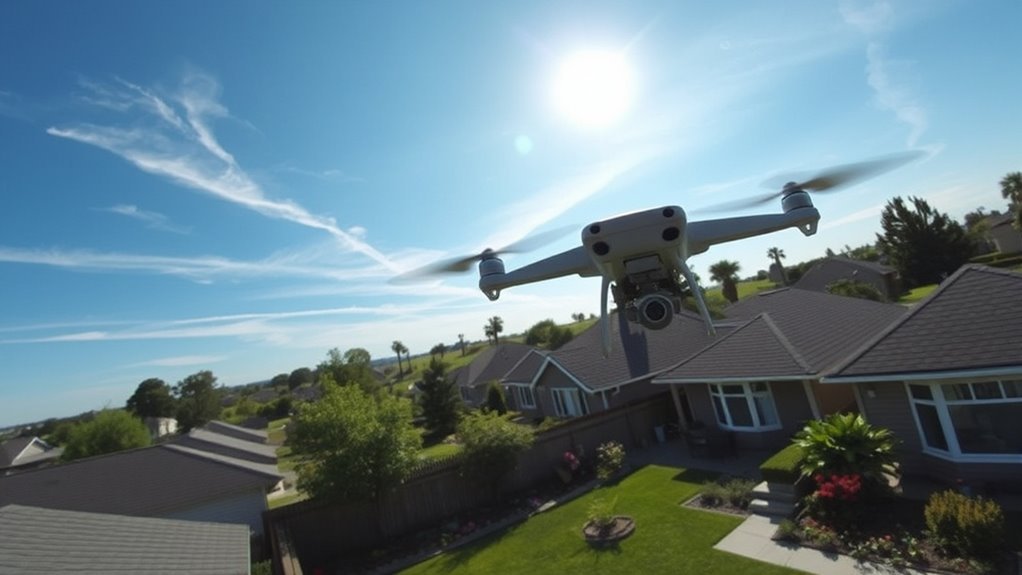When flying drones over houses, you must comply with FAA regulations and local laws. Make sure your drone is registered if it weighs over 0.55 pounds and be aware of airspace classifications. Respect private property boundaries to avoid legal issues and consider local ordinances that may restrict drone flights in residential areas. Always prioritize privacy and maintain a safe distance from people and homes. For a thorough understanding of these regulations, further insights await.
Understanding Drone Regulations in Residential Areas

When considering flying drones over residential areas, it is vital to understand the regulations governing such activities, as failure to comply can lead to legal repercussions. You must be aware of designated drone flight zones, as these dictate where you can operate your drone legally. Residential airspace is often subject to stricter regulations due to privacy concerns and potential safety hazards. It’s important to respect the boundaries of private property and guarantee you’re not infringing on neighbors’ rights. Familiarizing yourself with local ordinances and community guidelines can help you navigate these regulations effectively. By understanding the legal framework, you empower yourself to enjoy the freedom of drone flight while minimizing risks associated with non-compliance. Additionally, awareness of restricted zones is crucial to ensuring you do not inadvertently violate any regulations during your flight. In Connecticut, for example, privacy regulations prohibit unauthorized data collection over private property, emphasizing the need for consent before capturing images.
Federal Aviation Administration (FAA) Guidelines

Although you might be enthusiastic to fly your drone over residential areas, it’s crucial to understand the Federal Aviation Administration (FAA) guidelines that govern such activities. First, verify your drone is properly registered with the FAA, as this is a legal requirement for most drones weighing more than 0.55 pounds. Next, familiarize yourself with airspace classification; residential areas often fall under controlled airspace, which may restrict drone operations. You must avoid flying near airports and respect altitude limits. Remember, while the freedom to fly is enticing, compliance with FAA regulations is vital to guarantee safety and avoid potential legal repercussions. By adhering to these guidelines, you can enjoy your drone experience while respecting the rights of others.
State and Local Laws on Drone Usage

While the FAA establishes overarching regulations for drone use, state and local laws can impose additional restrictions that you must also consider. Understanding these regulations is vital for exercising your freedom responsibly. Here are three key aspects to keep in mind:
- State Regulations: Some states have specific laws governing drone operations, including altitude limits and flight zones, as outlined in local regulations and compliance.
- Local Ordinances: Municipalities may enact their own rules, restricting drone flights in parks, residential areas, or near critical infrastructure, which can vary significantly across different regions.
- Permits and Registration: Certain jurisdictions might require permits or registration for commercial drone use, differing from FAA requirements. Additionally, it’s important to be aware of designated areas where drone operation is permitted to avoid legal issues.
Always check local and state regulations before flying to guarantee you’re compliant and can enjoy your drone experience without legal repercussions.
Respecting Privacy Rights While Flying Drones
Understanding state and local regulations is just the beginning; respecting the privacy rights of individuals is equally important when flying drones. Privacy concerns arise when drones capture images or data without consent. Practicing drone etiquette can help you navigate these issues effectively. It is essential to be aware that federal airspace regulations govern drone operation to ensure compliance with the law.
| Action | Consideration |
|---|---|
| Inform neighbors | Discuss your flying plans |
| Avoid hovering | Respect personal space |
| Minimize recordings | Limit data collection |
Best Practices for Responsible Drone Operation
When you operate a drone, adhering to best practices is essential to confirm compliance with regulations and promote safety within the community. By following these guidelines, you’ll enhance drone safety and exhibit proper flight etiquette:
- Maintain a safe distance: Always keep your drone at least 25 feet away from people and private property to minimize risks and respect personal space. Additionally, be aware of local no-fly zones to avoid unintentional violations.
- Stay informed of regulations: Familiarize yourself with local laws and FAA rules to assure your flight operations are legal and responsible.
- Avoid flying over crowds: Steer clear of densely populated areas during your flights to prevent accidents and maintain public trust in drone technology. Additionally, consider monitoring weather conditions to ensure safe flying and avoid unexpected challenges.
Frequently Asked Questions
Can I Fly a Drone Over My Own House?
If you’re considering flying a drone over your own house, you’re generally allowed, but must adhere to drone regulations. Respecting property rights is essential, so make sure you’re compliant to avoid potential legal issues.
What Happens if I Fly Over Someone Else’s Property?
If you fly a drone over someone else’s property, you could face legal issues under drone trespassing laws. Such actions may raise privacy concerns, potentially leading to complaints or legal repercussions from the property owner.
Are There Restrictions for Commercial Drone Flights Over Residences?
Yes, there’re restrictions for commercial drone flights over residences. You must adhere to regulatory guidelines and consider airspace classification, ensuring compliance to maintain the freedom to operate while respecting privacy and safety regulations.
Do I Need Insurance to Fly a Drone Over Houses?
You don’t technically need insurance to fly a drone over houses, but obtaining drone insurance with liability coverage is highly advisable. It protects you from potential claims arising from accidents or damages during your flights.
How Can I Report a Drone Flying Too Close to My Home?
To report a drone flying too close to your home, document the incidents, noting times and noise complaints. Contact local authorities or relevant aviation regulatory bodies to address potential drone privacy violations effectively.

